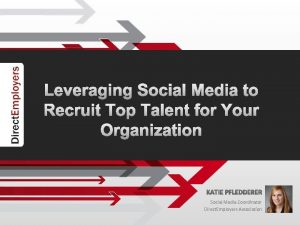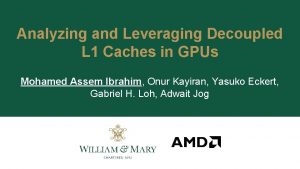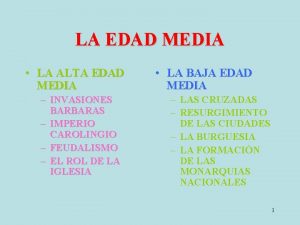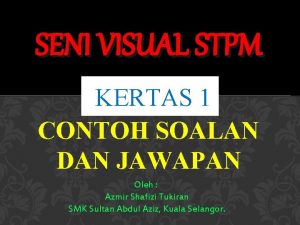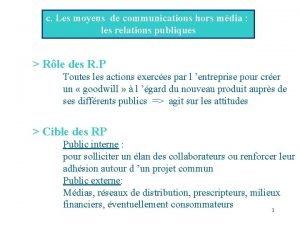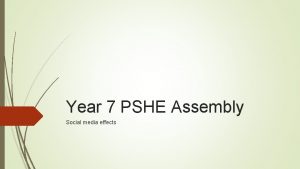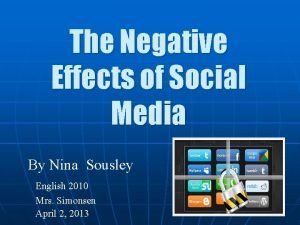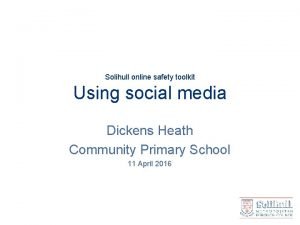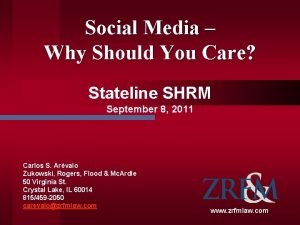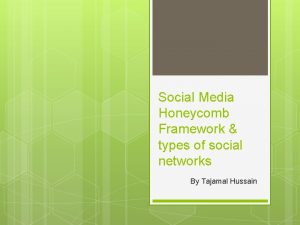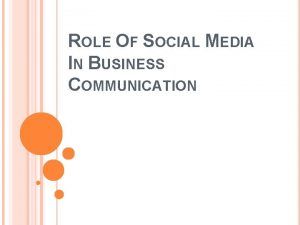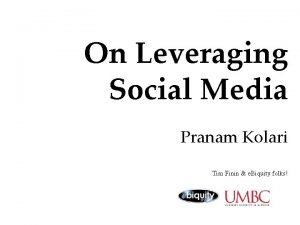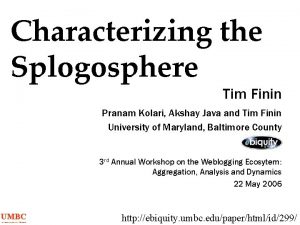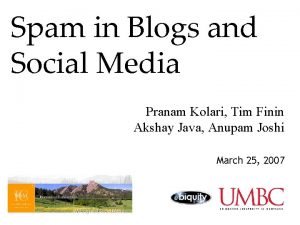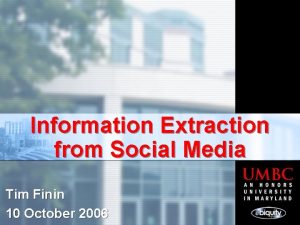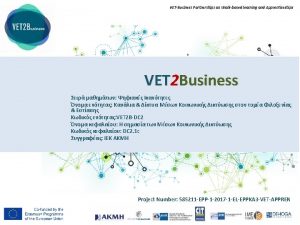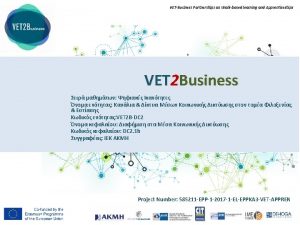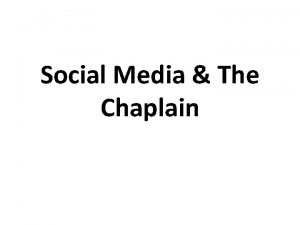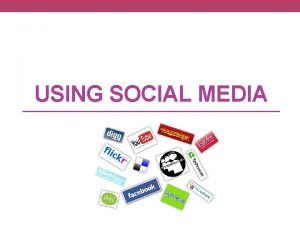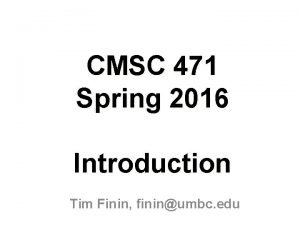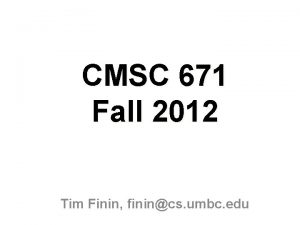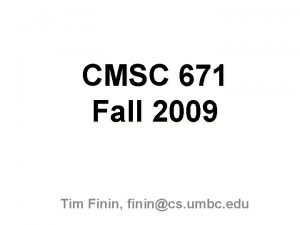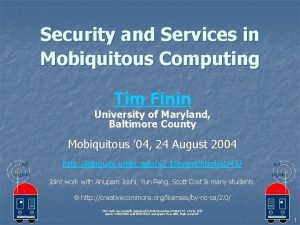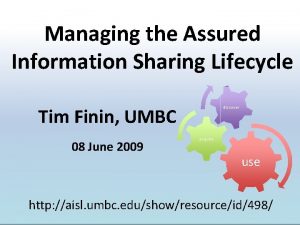On Leveraging Social Media Pranam Kolari Tim Finin

















































![SPAM TAXONOMY INTERNET SPAM [Forms] DIRECT INDIRECT Bookmark Spam E-Mail Spam IM Spam (SPIM) SPAM TAXONOMY INTERNET SPAM [Forms] DIRECT INDIRECT Bookmark Spam E-Mail Spam IM Spam (SPIM)](https://slidetodoc.com/presentation_image_h2/66e16cba9fad701ad61a27d1b8b1705f/image-50.jpg)



- Slides: 53

On Leveraging Social Media Pranam Kolari Tim Finin & e. Biquity folks!

SOCIAL MEDIA Social media describes the online technologies and practices that people use to share opinions, insights, experiences, and perspectives with each other. Wikipedia 06

SOCIAL MEDIA Social media describes the online technologies and practices that people use to share opinions, insights, experiences, and perspectives and engage with each other. Wikipedia 07

SOCIAL MEDIA • Engagement protocols defined by platforms; – Blogs, Social Networks, Wiki, Micro-blogs • around content types; – text, audio, video, read-write Web, avatars • instantiated by applications; – Live Spaces, You. Tube, Wikipedia, flickr • enabling online communities.

SOCIAL MEDIA • Pew (2007) : 55 percent of American youth age 12 to 17 use online social networking sites • Hitwise (February 2007): 6. 5% of all Internet visits for social networking sites • Andrew Tomkins at ICWSM 2007 – – Professional vs. Personal (Social) Content 4 GB/day vs. 5 -10 GB/day (minus songs/videos) 90% vs. 10% clicks good ranking vs. crazy good ranking

SOCIAL MEDIA RESEARCH Efforts best described by published papers in 3 workshops (2004, 2005, 2006) and at ICWSM 2007 A simple experiment…

SOCIAL MEDIA RESEARCH Social Media: 2004, 2005, 2006 communities, analysis, ties, moods, bloggers, weblogs, topics, blogs, weblog, blogosphere, blog Web: www 2007 database, ontology, server, user, applications, databases, policies, services, personalized, scalable, mobile, networks, xml, semantic

SOCIAL MEDIA RESEARCH Social Media: 2007 people, corporate, comments, visualization, personal, trust, social, sentiment, analysis, blogs, blogosphere Web: www 2007 ontology, server, databases, policies, services, scalable, queries, xml, search, web

SOCIAL MEDIA RESEARCH Social Media: 2007 cs. pitt. edu, staff. science. uva. nl, miv. t. u-tokyo. ac. jp, del. icio. us, icwsm. org, ebiquity. umbc. edu Web: www 2007 research. yahoo. com, cs. washington. edu, research. ibm. com, research. att. com, cs. cornell. edu, cs. cmu. edu, www 2007. org, research. microsoft. com

SOCIAL MEDIA RESEARCH • • • Modeling Bias through Link-Polarity Mining micro-blogs Social Media and the Semantic Web Internal Corporate Blogs Spam in Blogs/Social Media

LINK-POLARITY IN BLOGS “ … Michelle Malkin’s brilliant analysis of the immigration bill is right on the mark. As usual, the moonbats on the left are all over the place. Check out Atrios’ idiotic and corrupt argument for supporting the fatally flawed bill. …”

LINK-POLARITY IN BLOGS • Exploit argumentative and unedited nature of blog posts • Represent the opinion (and strength) of source blog about destination blog by analyzing a window of text around post hyperlink; [-1, +1] • Belief Matrix (B) as opposed to Transition Matrix (T) • Enables leveraging existing work in the area of “Trust Propagation in Networked Environments”

BIAS (TRUST) PROPOGATION B C A DIRECT A C A B D C COUPLING A TRANSPOSE CO-CITATION B C

BIAS (TRUST) PROPOGATION • R. Guha’s Trust Framework • A small number of expressed trust/distrust allows predicting trust between any two individuals with high accuracy • Incorporating trust propagation – Ci = a 1 * B + a 2 * BT*B + a 3 * BT + a 4 * B*BT – ai {0. 4, 0. 1, 0. 1} represents weighing factor • Trust Matrix (M) after ith atomic propagation – Mi+1 = Mi * Ci

IDENTIFYING MSM BIAS Left Leaning Right Leaning

SOCIAL MEDIA RESEARCH • • • Modeling Bias through Link-Polarity Mining micro-blogs Social Media and the Semantic Web Internal Corporate Blogs Spam in Blogs/Social Media

MICRO-BLOGS

TWITTERMENT

TWITTERMENT

SOCIAL MEDIA RESEARCH • • • Modeling Bias through Link-Polarity Mining micro-blogs Social Media and the Semantic Web Internal Corporate Blogs Spam in Blogs/Social Media

SEMANTIC WEB • Many are exploring how Semantic Web technology can work with social media • Background of our work on the Semantic Web -- Swoogle • Social media like blogs are typically temporally organized – valued for their timely and dynamic information! • Maybe we can (1) help people publish data in RDF on their blogs and (2) mine social media sites for useful information

An NSF ITR collaborative project with • University of Maryland, Baltimore County • University of Maryland, College Park • U. Of California, Davis • Rocky Mountain Biological Laboratory

INVASIVE SPECIES • Nile Tilapia fish have been found in a California lake. • Can this invasive species thrive in this environment? • If so, what will be the likely consequences for the ecology?

SPOTter button Once entered, the data is embedded into the blog post and Swoogle is pinged to index it

Prototype SPOTter Search engine

Prototype splickr Search engine

SOCIAL MEDIA RESEARCH • • • Modeling Bias through Link-Polarity Mining micro-blogs Social Media and the Semantic Web Internal Corporate Blogs Spam in Blogs/Social Media

GROWTH OF BLOGS • 50, 000 Weblogs (July 2006) • Doubling in size every 6 months for the past 3 years

MOTIVATION • What are the characteristics of Internal Blogs? – How are they growing? – Who uses them? – How would you quantify the nature of conversations? • How does this map to Corporate Hierarchy? • How best to exploit Internal Blogs? – Bottom-up competitive Intelligence – Emergence of Experts • What next with tools for Internal Blogs?

> Apache Roller Publishing Platform > Similar (less customized) platform used by Sun (Public Facing) Blogs http: //blogs. sun. com/

Landing page lists recent entries, popular entries and *hot* blogs

BACKGROUND 300 K 23 K Adopters 4 K Active Users Employees • • • Means to initiate collaboration Protection of ownership to ideas Platform for leadership emergence Audience to discuss work practices Asset to overall Internal Business Intelligence

BACKGROUND • Blog host database from November 2003 to August 2006 • ~23 K blogs • ~48 K posts, ~48 K comments/trackbacks • Employee Database of around ~300 K • Support and Feedback from the highly enthusiastic internal blogging community

GEOGRAPHICAL SPREAD • US leads the pack • UK, CA good adoption • Japan highest in Asia • Rest catching up Distribution of Blog Users Adoption closely mirrors those seen on the external blogosphere

GROWTH • Blogs double in 10 months • Posts double in 6 months Top-down guidance and organizational policies key to internal blogging adoption

RETENTION/ATTRITION Definition: A user who posted during a specific month is considered retained if he/she reposts at least once in the following x(6) months Ability of the community to engage and retain new users has improved significantly

TAG USE DISTRIBUTION • Typical Power Law Distribution – Some tags are popular with a long tail of less popular tags • What can we draw from these two data points? • Is this related to quality of a folksonomy?

LINKING BEHAVIOR Posts over 2 months Feature Hyperlinks 60% Feature Internal Links Feature External Links Feature Internal Blog Links • Internal themes are widely discussed • More conversations are through comments, few through trackbacks 40% 30% 10%

NETWORK BACKGROUND • G(V, E) – Every user u is in V – User u commenting/trackbacking on one or more posts by user v creates an edge (u, v) • 75 -80% of the nodes were disconnected – Created a blog with no post – Not commented on other posts, not a recipient of comments • ~4. 5 K Nodes • ~17. 5 K Edges

DEGREE DISTRIBUTION • In-degree slope -1. 6 • Out-degree slope -1. 9 • Web (-2. 1, -2. 67) • E-mail (-1. 49, -2. 03)

GLOBAL CONVERSATIONS POST COMMENT US JP UK CA IN DE CN AU BR US 41. 4 0. 3 8. 9 4. 4 0. 6 1. 4 0. 2 1. 2 0. 4 JP 2. 1 4. 3 0. 5 0. 2 0. 0 0. 1 0. 0 UK 7. 4 0. 1 8. 0 1. 0 0. 2 0. 6 0. 0 0. 3 0. 1 CA 4. 3 0. 1 1. 2 2. 6 0. 1 0. 2 0. 0 IN 0. 8 0. 0 0. 3 0. 1 0. 6 0. 1 0. 0 DE 1. 1 0. 0 0. 5 0. 2 0. 1 0. 3 0. 0 0. 1 0. 0 CN 0. 1 0. 0 0. 2 0. 0 AU 1. 0 0. 5 0. 1 0. 0 0. 3 0. 0 BR 0. 2 0. 0 0. 1 0. 0 0. 2

GLOBAL CONVERSATIONS • All pairs shortest path • Ranked Edges by Centrality • Plot ratio of inter-geography conversations in top x edges Conversations are still limited by language barriers, global conversations are key to information diffusion

REACH/SPREAD “Reach” measures distance between all conversations on a post independently, while “Spread” measures them together – based on the corporate hierarchy. REACH = 3+5+6 = 14/3 C(3) C(5) P C(6) SPREAD = 8/3

REACH/SPREAD • Posts with spread = 1 (Employee/Manager) quite low • Spread peaks around “ 4” showing intra-department conversations The notion of spread in addition to showing nature of conversations can also contribute to new metrics

DERIVED METRICS Additional Ranking Measures Meme Tracking: Overall Spread of Conversations on a Post Trend Identification: Tags attached to high “meme” posts can correlate with emerging interests Finding Experts: Authorities on topics by identifying meme and their topics

SOCIAL MEDIA RESEARCH • • • Modeling Bias through Link-Polarity Mining micro-blogs Social Media and the Semantic Web Internal Corporate Blogs Spam in Blogs/Social Media


Widget Spam Admiration Spam!?

WHAT IS SPAM? • “Unsolicited usually commercial e-mail sent to a large number of addresses” – Merriam Webster Online • As the Internet has supported new applications, many other forms are common, requiring a much broader definition Capturing user attention unjustifiably in Internet enabled applications (e-mail, Web, Social Media etc. . )
![SPAM TAXONOMY INTERNET SPAM Forms DIRECT INDIRECT Bookmark Spam EMail Spam IM Spam SPIM SPAM TAXONOMY INTERNET SPAM [Forms] DIRECT INDIRECT Bookmark Spam E-Mail Spam IM Spam (SPIM)](https://slidetodoc.com/presentation_image_h2/66e16cba9fad701ad61a27d1b8b1705f/image-50.jpg)
SPAM TAXONOMY INTERNET SPAM [Forms] DIRECT INDIRECT Bookmark Spam E-Mail Spam IM Spam (SPIM) Comment Spam Blogs (Splogs) Social Network Spam General Web Spam [Mechanisms] Social Media Spamdexing

DETECTING SPLOGS Increasing Cost PRE-INDEXING SPING FILTER Ping Stream 85% REGULAR EXPRESSIONS Ping Stream LANGUAGE IDENTIFIER BLACKLISTS WHITELISTS Ping Stream IP BLACKLISTS AUTHENTIC BLOGS URL FILTERS 90% HOMEPAGE FILTERS 95% FEED FILTERS BLOG IDENTIFIER PING LOG

CONCLUSION No. . This is just the beginning!

THANK YOU!
 Leveraging social media for talent acquisition
Leveraging social media for talent acquisition Definition of people media
Definition of people media Performance ambiguity lowers the cost of control.
Performance ambiguity lowers the cost of control. Brand leveraging strategies
Brand leveraging strategies Building customer based brand equity
Building customer based brand equity Primary and secondary brand associations
Primary and secondary brand associations Secondary brand association example
Secondary brand association example Coso three lines of defense
Coso three lines of defense Three lines of defense adalah
Three lines of defense adalah Analyzing and leveraging decoupled l1 caches in gpus
Analyzing and leveraging decoupled l1 caches in gpus Leveraging educational assistance partnership
Leveraging educational assistance partnership Leveraging threat intelligence
Leveraging threat intelligence Leveraging network effects
Leveraging network effects Leveraging subsidiary skills
Leveraging subsidiary skills Light search and rescue operations
Light search and rescue operations Social thinking social influence social relations
Social thinking social influence social relations Social thinking social influence social relations
Social thinking social influence social relations Difference selective and differential media
Difference selective and differential media Perbedaan media jadi dan media rancangan
Perbedaan media jadi dan media rancangan Major advertising decisions
Major advertising decisions Alta edad media y baja edad media
Alta edad media y baja edad media Caracteristicas de la baja edad media
Caracteristicas de la baja edad media Media hot and cold
Media hot and cold Differential vs selective media
Differential vs selective media Vogue 1965 media studies
Vogue 1965 media studies Contoh esei seni stpm
Contoh esei seni stpm Hot media and cold media
Hot media and cold media Les moyens de communication hors média
Les moyens de communication hors média Wired data transfer
Wired data transfer Perbedaan media jadi dan media rancang
Perbedaan media jadi dan media rancang Hot media and cold media
Hot media and cold media New media vs old media
New media vs old media Executive social media strategy
Executive social media strategy Social media assembly
Social media assembly Big data and social media analytics
Big data and social media analytics Social media good and bad effects
Social media good and bad effects Future of social media 2050
Future of social media 2050 Asset management companies using social media
Asset management companies using social media Christian social media platform
Christian social media platform Content pillar template
Content pillar template Social media solihull
Social media solihull Social media policy shrm
Social media policy shrm Organic social media
Organic social media Social media training plan presentation
Social media training plan presentation Conclusion of social media
Conclusion of social media Social media presenter
Social media presenter Social media
Social media Jessica gosney
Jessica gosney Honeycomb framework of social media
Honeycomb framework of social media Social media consumer insights
Social media consumer insights Abhimanyu shankhdhar, jims / social media and businss /
Abhimanyu shankhdhar, jims / social media and businss / Compositional modes for digital media
Compositional modes for digital media Facebook in business communication
Facebook in business communication Opportunity in media
Opportunity in media
